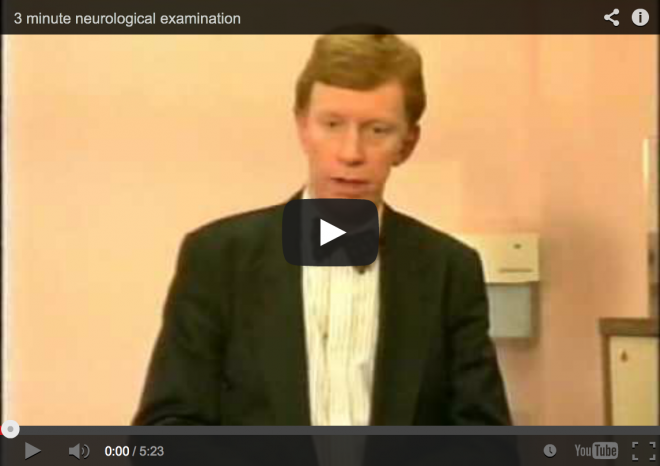The 3 Minute Neurological Examination is an excellent screening neurological examination which is executed with nearly impeccable skill in two minutes flat. The explanation section, which follows the demonstration, is excellent too!
Tests/commands performed are:
- With eyes closed: Romberg test (proprioception).
- With eyes opened: tandem gait (heel-to-toe walking).
- Walk on tip toes (power test of plantar flexion).
- Walk on heels (power test of dorsiflexion).
- With eyes closed: test for pronator drift (pyramidal tracts, test for neglect).
- Finger-to-nose test (light touch (!), cerebellar function).
- With eyes opened: “play the piano” (pyramidal function).
- Rapid tapping or alternating movements (test for ataxia).
- With eyes closed: “screwing” eyelids shut tightly (Cranial Nerve VII, upper)
- With eyes opened: observe pupillary reflex in response to eyes opening (CN II, III).
- Grin (Cranial Nerve VII, lower).
- Stick tongue out (Cranial nerve XII).
- Rapid tongue movements (test for pseudobulbar palsy).
- Visual fields by confrontation (Cranial Nerve II).
- Eye movements (Cranial Nerves III, IV & VI).
- Reflexes (supinators, biceps, patellar, ankle jerk).
- Babinski (pyramidal tract).
- Funduscopy (bilaterally, in twelve seconds flat!).
Hat tip to Life in the Fast Lane.
The demonstration was performed by Dr. Giles Elrington who wrote in the comment section below:
I am the neurologist who is in this video from 1997…. I am pleased some people like it, initially I was worried it was heretical but it has been much better received than I feared. Yes I saw her optic discs (if fundoscopy is difficult, just practice repeatedly; dogs make useful subjects!). Ankle reflexes elicited this way was for modesty. I should have done the visual fields congruously (upper with upper, lower with lower. I often add a quick check for cogwheel rigidity plus synkinesis.
From comment section (below)


Leave a Reply